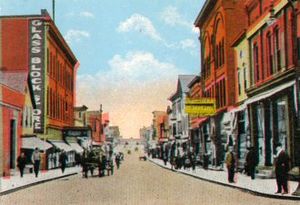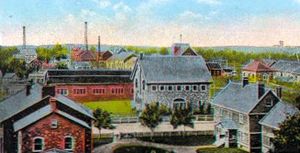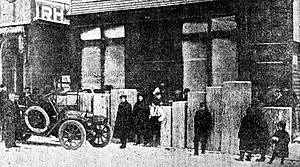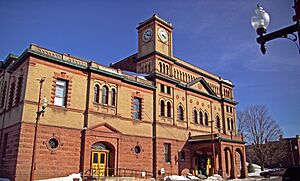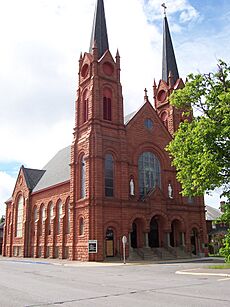Calumet, Michigan facts for kids
Quick facts for kids
Calumet, Michigan
|
|
|---|---|
|
Village
|
|
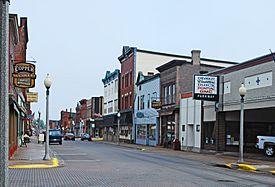
Looking north along 5th Street
|
|
| Nickname(s):
"Coppertown USA"
|
|

Location within Houghton County
|
|
| Country | |
| State | |
| County | Houghton |
| Township | Calumet |
| Settled | 1864 |
| Area | |
| • Total | 0.20 sq mi (0.52 km2) |
| • Land | 0.20 sq mi (0.52 km2) |
| • Water | 0.00 sq mi (0.00 km2) |
| Elevation | 1,214 ft (370 m) |
| Population
(2020)
|
|
| • Total | 621 |
| • Density | 3,105/sq mi (1,194.23/km2) |
| Time zone | UTC−5 (Eastern (EST)) |
| • Summer (DST) | UTC−4 (EDT) |
| ZIP Code |
49913
|
| Area code(s) | 906 |
| FIPS code | 26-12580 |
| GNIS feature ID | 0622468 |
Calumet is a small village in the Upper Peninsula of Michigan. It is located in Houghton County. In 2020, about 621 people lived there.
Calumet was once a very important place for copper mining in Michigan. Today, it is home to part of the Keweenaw National Historical Park. Many of its old buildings are listed on the National Register of Historic Places, showing its rich history.
Contents
Calumet's Rich History
Calumet was first settled in 1864. It was originally called Red Jacket. This name came from a Native American chief of the Seneca tribe. The name "Calumet" was actually used by a nearby town, Laurium, until 1895. The village we know as Calumet officially got its name in 1929.
Red Jacket grew quickly because of the many copper mines nearby. It became a town in 1867. The copper mines here were very rich. One company, the Calumet and Hecla Mining Company, produced more than half of all the copper in the United States between 1871 and 1880. Besides mining, people also worked in dairy farming and growing vegetables. Many immigrants from countries like Poland came to live and work here in the late 1800s.
Challenges and Changes
By 1900, Red Jacket had a population of 4,668 people. The larger area, Calumet Township, had almost 26,000 people. But in 1913, the town faced a big challenge: the Copper Country Strike of 1913–1914. This strike caused the population to start shrinking.
In the same year, a very sad event happened, known as the Italian Hall Disaster. Striking miners and their families were having a Christmas Eve party at the Italian Hall. Someone yelled "fire," which caused a panic. People rushed to get out, and 73 victims were crushed or suffocated. More than half of them were children under ten years old. No one ever found out who yelled "fire." The folk singer Woody Guthrie wrote a song about this event called "1913 Massacre."
After World War I, the demand for copper dropped. This caused copper prices to fall. Thousands of people left Red Jacket in the 1920s. Many moved to Detroit, where the automobile industry was growing fast.
During the Great Depression, most of the mines closed down. This made even more miners and their families leave to find work. By 1950, Calumet's population was only 1,256 people. Some small-scale mining continued, especially during World War II. But all mining stopped completely after a labor strike in 1968.
In 1984, Calumet's name was used in a Hollywood movie. The film Red Dawn imagined a town called Calumet in Colorado being invaded by Soviet soldiers. The movie's writer, Kevin Reynolds, spent time in the Keweenaw Peninsula.
Calumet's Geography
Calumet is a small village, covering about 0.20 square miles (0.52 square kilometers) of land. It sits about 1,209 feet (368 meters) above sea level.
Underneath the village, there are thousands of miles of old mine tunnels. These tunnels have been empty for many years. A large part of the Keweenaw National Historical Park is located right inside the village. This park area includes the main buildings of the old Calumet and Hecla Mining Company.
Getting Around Calumet
Major Roads
- US 41 runs just outside Calumet. It connects the village to towns like Hancock and Houghton to the southwest. It also leads to larger cities like Marquette.
- M-26 is a nearby road. It connects Calumet to Laurium and Lake Linden.
- M-203 is north of the village. It's a scenic route that takes you to McLain State Park.
Airport
The Houghton County Memorial Airport (KCMX) serves Calumet and the nearby communities. It's located in a place called Oneco.
Old Train Routes
Calumet used to have several train lines:
- The Copper Range Railroad went through Calumet. It carried copper ore to processing mills.
- The Hecla & Torch Lake Railroad also moved ore from the mines in the village to mills in Lake Linden.
- The Mineral Range Railroad also operated in the area.
People and Culture
Delicious Local Food
One of the most famous foods in Calumet and the whole Copper Country is the pasty. This was a very important meal for copper miners. A pasty is like a savory pie. It has meat, potatoes, rutabaga, carrots, and onions, all wrapped in a pastry crust. Pasties came from Cornish miners.
Calumet even has a "Pasty Fest" every summer! It's a fun event with pasty eating contests, games, and live music. There's even a tug-of-war where the losing team falls into a pool of ketchup!
Historic Calumet Theatre
The Calumet Theatre is a beautiful old theater and opera house that opened in 1900. In the late 1800s, the copper mining business was doing very well. The town had extra money and decided to build a theater. Many famous actors, musicians, and opera singers performed there.
When the mines closed, the theater became a movie theater and fell into disrepair. But in 1975, the town started a big project to fix and restore it. Today, the Calumet Theatre is used for many local shows and touring performances. It is also a Michigan State Historic Site.
Summer Fun
Every two years, graduates of Calumet High School have a big reunion. Many fun activities happen during this time, including a classic car show and parade.
Pasty Fest is a special one-day event held every summer in downtown Calumet. It celebrates the pasty, a traditional food brought by Cornish miners. The festival includes a parade, a street fair, live music, and a pasty eating contest. Restaurants also compete to see who makes the best pasty!
Education in Calumet
Public schools in Calumet are part of the Public Schools of Calumet-Laurium-Keweenaw district. Students attend Calumet High School. Their sports teams are known as the "Copper Kings."
Churches in Calumet
St. Paul the Apostle Church
St. Paul the Apostle Church was first built in 1889 by Slovenian immigrants. They came to Calumet to work in the copper mines. The first church burned down in 1902, but a new one was built by 1908. This church is made of local sandstone and has beautiful stained glass windows. It also has a large pipe organ and a wonderfully painted inside.
In 1966, several Catholic churches in the Calumet area merged because there were fewer people attending. St. Paul the Apostle Church is now home to a large and active group of people who help take care of the historic building.
Other Churches
In the past, Calumet had many different churches. There were six Lutheran churches, three Methodist churches, and also Episcopal, Congregationalist, Baptist, and Presbyterian churches. Today, some of these churches are still open, while others are no longer used.
Population Changes
| Historical population | |||
|---|---|---|---|
| Census | Pop. | %± | |
| 1880 | 2,140 | — | |
| 1890 | 3,073 | 43.6% | |
| 1900 | 4,668 | 51.9% | |
| 1910 | 4,211 | −9.8% | |
| 1920 | 2,390 | −43.2% | |
| 1930 | 1,557 | −34.9% | |
| 1940 | 1,400 | −10.1% | |
| 1950 | 1,256 | −10.3% | |
| 1960 | 1,139 | −9.3% | |
| 1970 | 1,007 | −11.6% | |
| 1980 | 1,013 | 0.6% | |
| 1990 | 830 | −18.1% | |
| 2000 | 879 | 5.9% | |
| 2010 | 726 | −17.4% | |
| 2020 | 621 | −14.5% | |
| U.S. Decennial Census | |||
Calumet's population has changed a lot over the years. In 1900, it had its highest population with 4,668 people. After the copper mines closed and people moved away for work, the population slowly decreased. In 2020, the village had 621 residents.
Fun Places to Visit
Calumet has many interesting places to see:
- The Calumet Theatre, which opened in 1900, was one of the first theaters built by a town in the United States.
- The old 1898 Red Jacket Fire Hall on 6th Street is now the Copper Country Firefighters Museum. It's built from local sandstone.
- The Calumet Visitor Center is a museum about the area's mining history. It's run by the Keweenaw National Historical Park.
- The Keweenaw Storytelling Center is in a historic building. It's where the The Red Jacket Jamboree radio show is recorded.
- The Calumet Historic District is a special area recognized for its important history.
- The Calumet Colosseum is the oldest ice rink in North America that is still being used today.
- Lions Park is a great place for outdoor activities. It has trails, lake views, and even a disc golf course.
Famous People from Calumet
Many notable people have connections to Calumet:
- Hunk Anderson, a famous football coach for teams like Notre Dame and the Chicago Bears.
- Anna Clemenc (also known as "Big Annie"), a labor activist and local hero.
- Jeff Finger, a professional ice hockey player.
- Paul J. Smith, a music composer who wrote music for Disney films.
- James Tolkan, an actor known for his roles in movies like Back to the Future and Top Gun.
Images for kids
-
The site of the now-razed Italian Hall. This was the site of the Italian Hall disaster, one of the most tragic events in American labour history and the climax of a bloody, tense strike. The event changed the Keweenaw forever.
-
Interior of the Calumet Theatre on 6th Street
See also
 In Spanish: Calumet (Míchigan) para niños
In Spanish: Calumet (Míchigan) para niños




